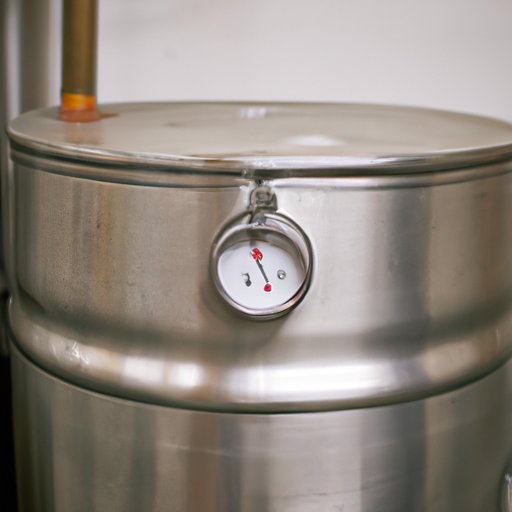Introduction
Have you ever found yourself unsure of how many gallons are in a keg? Whether you’re throwing a party or running a bar, it’s important to understand keg volumes and measurements in order to make sure you have enough beer on tap. In this article, we’ll provide a comprehensive guide to various keg sizes and their exact gallon measurements, as well as tips for calculating keg volume and pouring beer from a keg. Use this guide to confidently purchase and pour beer kegs at any event.
All You Need to Know: The Exact Number of Gallons in a Keg
Keg sizes are measured in gallons, with the most common size being the half barrel (also known as a full keg), which holds 15.5 gallons. Other standard keg sizes include quarter barrels (7.75 gallons), slim quarter barrels (7.75 gallons, but taller and slimmer than a traditional quarter barrel), and sixth barrels (5.17 gallons, also known as “sixtels”).
Kegs 101: Understanding the Volumes and Measurements of Different Keg Sizes
Let’s take a closer look at standard keg sizes and their exact measurements in gallons:
- Half barrel/full keg – 15.5 gallons
- Quarter barrel – 7.75 gallons
- Slim quarter barrel – 7.75 gallons
- Sixth barrel/sixtel – 5.17 gallons
In addition to these standard keg sizes, there are also specialty keg sizes available, such as pony kegs (which typically hold 1/6 or 1/4 barrels and are ideal for smaller gatherings) and oversized kegs (which can hold up to 20 gallons and are commonly used for large events).
From Pints to Gallons: A Comprehensive Guide to Calculating the Volume of a Keg
If you need to calculate the volume of a keg, there are a few different units of measurement you can use. One gallon is equal to 128 ounces, or 16 cups, or 8 pints. Therefore:
- Half barrel/full keg – 1,984 ounces or 124 pints or 62 cups or 15.5 gallons
- Quarter barrel – 992 ounces or 62 pints or 31 cups or 7.75 gallons
- Slim quarter barrel – 992 ounces or 62 pints or 31 cups or 7.75 gallons
- Sixth barrel/sixtel – 661 ounces or 41 pints or 20.5 cups or 5.17 gallons
Keep in mind that when beer is poured from a keg, it creates foam and waste, meaning you can’t actually pour the full volume of the keg.
How Many Beers Can You Pour from One Keg? The Answer Lies in its Gallon Capacity
The number of beers you can pour from a keg depends on the keg size and the volume of each pour, typically 12 ounces. Using the conversions above, we can estimate how many beers can be poured from each standard keg size:
- Half barrel/full keg – 165 12-ounce pours
- Quarter barrel – 82 12-ounce pours
- Slim quarter barrel – 82 12-ounce pours
- Sixth barrel/sixtel – 55 12-ounce pours
Keep in mind that this is only an estimate and the actual number of beers that can be poured will depend on a variety of factors including foam, waste, and the size of each individual pour.
Size Matters: Exploring the Relationship Between Keg Sizes and Gallons
When deciding on a keg size, consider the advantages and disadvantages of each size based on gallonage. For example, a half barrel keg might be too much beer for a small gathering, but a quarter barrel keg might not be enough for a large event.
Here are some common situations where different keg sizes are appropriate:
- Half barrel/full keg – large parties and events, bars and restaurants with high volume
- Quarter barrel – small parties and home use
- Slim quarter barrel – fits in smaller spaces, same volume as a traditional quarter barrel
- Sixth barrel/sixtel – smaller gatherings and home use, easy to transport
The Dos and Don’ts of Buying Kegs: Understanding the Importance of Gallon Measurements
When buying kegs, it’s important to know the exact gallon measurements in order to purchase the right sized keg for your event. Here are some tips:
- Determine how many people will be drinking and how much beer they’re likely to consume
- Consider the type of event and the length of time it will last
- Check with your local brewery or distributor to find out what keg sizes they have available
- Don’t buy a keg that’s too big or too small for your event, as it can lead to waste or running out of beer
Conclusion
Understanding keg volumes and measurements is essential for anyone purchasing or pouring beer from a keg. Use this comprehensive guide to confidently select the right keg size and calculate its volume, as well as pour the appropriate amount of beer for your event. Whether you’re hosting a small party or running a large bar, knowing how many gallons are in a keg is a must for a good time.
